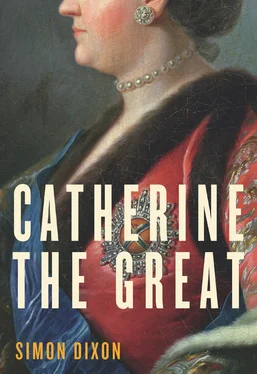Gift-giving was a central part of Court culture, and although Catherine might occasionally expect to receive presents from visiting royalty, she was usually expected to offer them. On the night of her conversion to Orthodoxy, she had been able to present Peter with a jewel-encrusted hunting knife and a gold cane-head only because Elizabeth had provided them for her. After her marriage, she had to pay for her own presents. The empress set the standard, providing courtiers with new clothes every Easter and bestowing valuable dowries on her maids of honour. Her stepsister Anna Karlovna received 10,000 roubles when she married Chancellor Mikhail Vorontsov in 1742. Sixteen years later, their daughter Anna Mikhailovna in turn received 15,000 roubles along with dresses, silks and bed linen that brought the total value of the gift to more than 25,000 roubles. 43So we may believe Catherine when she complains of the demands of Countess Rumyantseva—‘the most spendthrift woman in Russia’—and Maria Choglokova, who alone was said to cost her 17,000 roubles a year. 44
* * *
Such sums were a drop in the ocean by comparison with the outlay required to sustain a rapidly expanding Court. Though it remained significantly smaller than Versailles or Vienna, the establishment in St Petersburg was beginning to spiral out of control at the time of Catherine’s arrival in Russia. 45In 1748, when a financial crisis prompted officials to compare Elizabeth’s household with the establishment under Anna in 1739, seven dwarves provided a reassuring measure of continuity, testifying to the Russian elite’s persistent fascination with human freaks. In every other respect, however, the Court had undergone unprecedented growth. Whereas Anna had managed with eight gentlemen-in-waiting, Elizabeth needed twice as many. She employed seven chamber pages, compared to Anna’s three, and the number of ordinary pages had increased from eight to fourteen. In 1739, the Court had required but a single cupbearer: nine years later there were six—and fourteen assistants. To manage them, the empress revived a series of offices unknown to Anna but mentioned in documents from previous reigns (among others, her Court now boasted a Chief Cellar-master and Chief Cupbearer). In view of her passion for clothes, a maître de garderobe seemed equally indispensable and Elizabeth duly appointed Vasily Chulkov, a former lackey who had looked after her wardrobe since 1731. Inflation was even more obvious among the burgeoning ranks of coffee-servers, table-cloth layers and table-setters. As for the lesser servants, Anna had made do with four chamber lackeys, forty-eight lackeys, eight heyducks and four messengers. By 1748, their total numbers had more than doubled. All of them had to be kitted out in expensive livery: at 13,000 roubles, Elizabeth’s annual bill on this count was more than three times higher than Anna’s. Lackeys, drawn mainly from the Ukrainian regiments, wore an outfit based on the standard Russian military uniform: green breeches and tunics with red cuffs and a scarlet cloth blouson. Heyducks dressed in red breeches, like the Hussars, and a fancier tunic, trimmed with lace, loops and large buttons. For state occasions and major religious feast days, the livery was still more extravagant. Below stairs, forty-five cooks manned Elizabeth’s kitchens in much the same way as they had done under Anna, but by 1748 they had sixty-eight apprentices to her eighteen. It was only because most of this mushrooming establishment were miserably paid—the eighty stokers each had to survive on 30 roubles a year, half as much again as the twenty grooms—that the increase in the total salary bill could be held at 239,331 roubles in 1748 by comparison with 148,388 in 1739. 46
The costs of consumption rose faster still. In 1746, the three palace kitchens responsible for preparing food for the empress, the grand ducal couple and the leading courtiers paid 10,721 roubles for wine and fresh vegetables—more than twice as much as Anna had spent. The drinks budget was even higher: 38,830 roubles in 1746 by comparison with 18,163 in the 1730s. (Despite the drunken portrait of her husband presented in Catherine’s memoirs, the 13,150 roubles spent on alcohol for her and Peter tell us less about their personal habits than about the central role they played in entertaining the Court and the foreign ambassadors.) Changing fashions led Elizabeth to pay three times as much for coffee as Anna had done, while the bill for sweets rose more than sevenfold to 6389 roubles. It was this ‘enormous number of sweets’ that contributed to the Russians’ lasting reputation for bad breath—‘especially at court’ reported a visitor in the early nineteenth century, ‘where the ladies not merely chew them all through dinner, but send plates back to their rooms’. 47All told, the catering budget for the imperial family and the leading courtiers in 1746 came to 83,714 roubles—well over twice as much as Anna’s total of 35,388—and actual expenditure was almost certainly higher. 48
Although the 1740s was the decade in which Peter the Great’s reforms finally began to take root in a number of areas of government, it would have taken a more robust accounting system than any Russia could command to control expansion on this scale. Not long before the national debt peaked in 1748 at around 3.6 million roubles—between a quarter and a third of the empire’s annual gross income—the Admiralty College blithely allocated more than 1.5 million roubles to an attempt to rebuild the military harbour at Kronstadt in stone, abandoning the plan three years later only when it learned that even an outlay of 3 million would offer no guarantee of success. 49The Court’s deficit may have been trivial by comparison, but by the time administrators worked it out for themselves, it was already too late. In theory, salaries and catering were accounted for by an annual state grant of 200,000 roubles, to which Elizabeth had added a recurrent supplement of 30,000 roubles in April 1747. Yet although payments were supposed to be made in instalments every four months, the Court Office complained that the money was transferred only ‘with great delays, and never in a single issue’. No funds at all were handed over on 1 May 1748, so that officials, already behind with salary payments and facing a formal protest from sentries who had been given no new uniforms for the past three years, now found themselves more than 43,000 roubles in arrears and unable to pay for the ‘drinks, Gdansk vodka, vegetables and other provisions without which it is impossible for the Court to manage, either for its ordinary needs or for banquets’. By mid-May, the Court Office’s resources were ‘utterly exhausted’: not only was there no money to buy luxury goods from the foreign vessels expected imminently in St Petersburg; they could not even afford to commission orders from the regular packet-boats that brought cloth and alcohol from Danzig. 50
* * *
Expensive as the Court had proved, there was never any question that Elizabeth would rein in her spending. In a political climate in which ‘the main currency of imperial competition was cultural achievement’, there was nothing self-indulgent about representational display. On the contrary, as Tim Blanning has shown, display was a ‘constitutive element of power itself’. And nowhere was it a more vital element than in Russia under the usurper Elizabeth, because the representational culture which radiated across Europe from Versailles was by no means an expression of unbounded confidence: ‘On the contrary, the greater the doubts about the stability or legitimacy of a throne, the greater the need for display.’ 51
For a sense of what that meant in practice, consider the magnificent four-poster bed in the state bedroom at Tsarskoye Selo. A shimmering confection of light-blue French damask fringed with silver brocade, this lit de parade was the most expensive piece of furniture in the palace. Above it hung a massive canopy decorated with crimson velvet into which a cross and a crown lying on a feather pillow had been embroidered in gold and silver. The interior of the canopy was embroidered with the empress’s monogram. 52No matter that the Russian Court had never adopted the elaborate public rituals of the lever and coucher practised at Versailles, or that Elizabeth preferred to sleep in a room next to Aleksey Razumovsky’s: the state bed’s purpose was representational rather than functional. And it was no more than Europe had come to expect. Touring the continent in the early 1750s, the young Demidov brothers, heirs to the precious-metal mines in the Urals, were proudly told that it had taken forty craftsmen twelve years to construct the bed at the Elector of Bavaria’s palace in Munich, where a dozen people were required merely to lift the bedspread. 53A later British visitor learned that the furniture in that bedroom alone had cost £100,000. 54
Читать дальше












